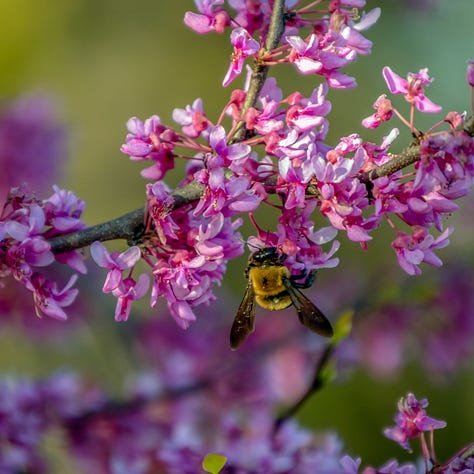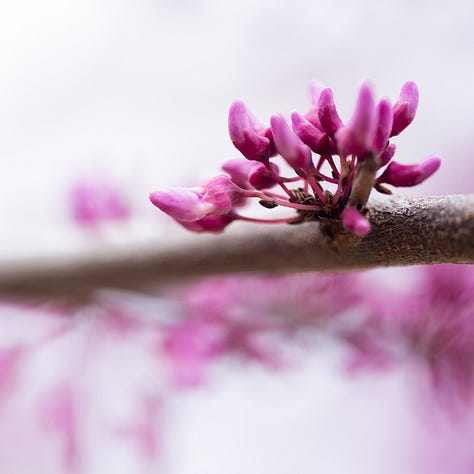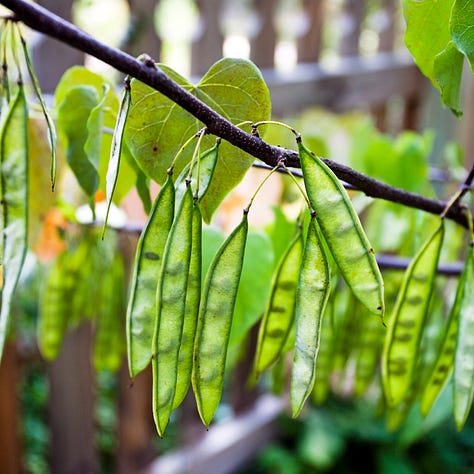Of Beauty & Purpose in All Seasons: Eastern Redbud
A favorite annual inflection point of mine arrives with cherished aromas, sights, sounds and tastes, calling upon my hands to once again become one with the soil. A harmony to embrace. This is where I feel whole. And where I know holy to be.
Local life is renewed, in a wave of magenta and rosy-pink blossoms, sometimes springing right out of the trunk! This extraordinary natural phenomenon, known as cauliflory or ramiflory, is incredibly rare amongst other species.
Producing an abundance of early nectar, Eastern Redbuds (Cercis canadensis) are commonly visited by humming birds as well as a vast array of our pollinating friends. Carpenter bees, bumblebees, mason bees, halictid bees, blueberry bees, honeybees and many, many others are reliant upon the resilience of this wondrous native tree, having co-evolved together for millennia. While serving as a host plant for the Redbud Leaffolder moth, the Redbud tree also feeds a wide variety of other butterflies and moths.



Several weeks after these sacred flowers appear, they are replaced by small, green, pea pod-like (of the same family) fruits which are joined by heart-shaped (cordate) leaves, making it easy to see why some cultures refer to it as the “Love Tree”. As the months pass, the leaves will gradually shift from a deep green to a light yellow in late summer while the pods will reach maturity around the start of autumn. As a smaller, deciduous tree, even in the winter, its shapely, rounded canopy maintains a distinct beauty that is generally unmatched amongst other flora.
Native to eastern North America, the Redbud ranges from as far north as Ontario, Canada on down to Florida, and as far west as central Texas. In addition to the array of happy pollinators, birds, squirrels, deer and other wildlife are known to enjoy the seeds. Further, ALL parts of this tree are also edible to humans! The flowers can add a colorful sweetness to salads while the leguminous seeds are roasted by indigenous peoples, and an extract from the root and/or bark has been used historically to treat cough, colds, fever and influenza.
Legend has it that George Washington was so enamored by this glorious tree that he transplanted some from the woods into his garden in Mount Vernon. With the versatility to flourish in very little or full sun, the Redbud will ultimately be more productive with a healthy dose of sunlight. "Cercis", derived from the Greek word Kerkis, meaning “a weaver’s shuttle”, was applied by Theophrastus (the successor of Aristotle) in reference to the fruit.
As Spring reveals, heals and invites us to more fully rekindle our relationship with Nature, the Eastern Redbud remains one of the first to extend this invitation. Even when we aren’t taking notice of its elegant blossoms, this “tree-mendous” specimen continues conserving and cleaning water, sequestering carbon, producing oxygen, enhancing air quality, providing shelter and shade, protecting soil and ecosystems, encouraging biodiversity and ameliorating climate change all while feeding wildlife, pollinators and humans!
Do you love Redbuds, Native plants, and/or Appalachia?! If so, I’m betting you’re also going to love the 2024 Radford Redbud Festival lineup! Featuring some of the very best live MUSIC | FOOD | ARTS | NATURE & PLANTS around, this New River Valley celebration will be hosted Nursery Natives at Nesselrod on the New on Saturday, April 13th.
OTHER UPCOMING EVENTS with Nursery Natives:
April 8th - Solar Eclipse Plant Extravaganza @ Sunset Park
April 11th & 12th - New River Symposium @ Radford University - hosted by the New River Conservancy






